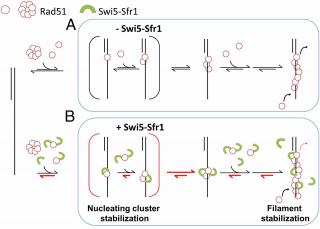Oct, 2018

Eukaryotic Rad51 protein is essential for homologous-recombination repair of DNA double-strand breaks. Rad51 recombinases first assemble onto single-stranded DNA to form a nucleoprotein filament, required for function in homology pairing and strand exchange. This filament assembly is the first regulation step in homologous recombination. Rad51 nucleation is kinetically slow, and several accessory factors have been identified to regulate this step. Swi5–Sfr1 (S5S1) stimulates Rad51-mediated homologous recombination by stabilizing Rad51 nucleoprotein filaments, but the mechanism of stabilization is unclear. We used single-molecule tethered particle motion experiments to show that mouse S5S1 (mS5S1) efficiently stimulates mouse RAD51 (mRAD51) nucleus formation and inhibits mRAD51 dissociation from filaments. We also used single-molecule fluorescence resonance energy transfer experiments to show that mS5S1 promotes stable nucleus formation by specifically preventing mRAD51 dissociation. This leads to a reduction of nucleation size from three mRAD51 to two mRAD51 molecules in the presence of mS5S1. Compared with mRAD51, fission yeast Rad51 (SpRad51) exhibits fast nucleation but quickly dissociates from the filament. SpS5S1 specifically reduces SpRad51 disassembly to maintain a stable filament. These results clearly demonstrate the conserved function of S5S1 by primarily stabilizing Rad51 on DNA, allowing both the formation of the stable nucleus and the maintenance of filament length.